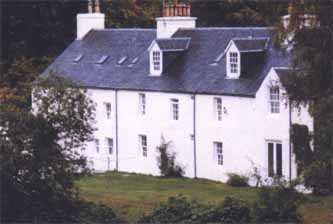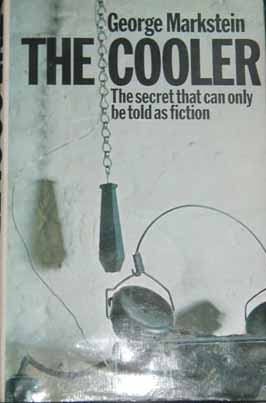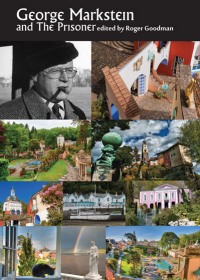THE
UNMUTUAL PRISONER LOCATIONS GUIDE
INVERLAIR
LODGE
Photos:
Dave Healey & Rick Davy. Location Info: Rick Davy, Martin Briscoe, Des Gorra,
Kevin Ryerson. Report: Dave Healey.
 LOCATION
INFO : Part of the inspiration for The Village in The Prisoner was
due to script-editor George Markstein's knowledge of Inverlair Lodge, near Inverness
in Scotland. The building was used as a "safe haven" for secret agents
during the Second World War (Markstein also claimed it was a "retirement
home for spies").
LOCATION
INFO : Part of the inspiration for The Village in The Prisoner was
due to script-editor George Markstein's knowledge of Inverlair Lodge, near Inverness
in Scotland. The building was used as a "safe haven" for secret agents
during the Second World War (Markstein also claimed it was a "retirement
home for spies").
Inverlair
Lodge (photo left) was also the inspiration for one of Markstein's novels, "The
Cooler" (review HERE).
LOCATION
REPORT:
It is widely
known that The Prisoner, at least in part, was influenced by stories of secret
institutions set up during World War II to house certain people who "knew
too much" or were a risk to national security. For obvious reasons details
of these establishments have received little publicity and the truth behind
them is still en-shrouded in secrecy. George Markstein, the script editor on
The Prisoner, is usually credited as revealing the existence of these clandestine
operations to McGoohan. His association with British Intelligence would certainly
have given him an awareness of these places and indeed he is often quoted as
referring to the existence of a wartime "village" called Inverlair
Lodge in Scotland. This wartime "prison" has often been referred to
as "The Cooler" and George Markstein used this as the title for his
1974 novel. A legend on the book's dust cover stated "The secret that can
only be told as fiction" and inside a short dedication read - "This
story is fiction. But there was a Cooler. Those who know about it don't have
to be told any more. Those who don't can't be told any more." Clearly the
book was based on Inverlair Lodge, with the fictional establishment dubbed Inverloch.

In 2013 the book "George Markstein and The Prisoner" was published,
which outlined much more of Markstein's knowledge and influence and beliefs.
More information about the book HERE.
The book is available to purchase HERE.

Other than
the name no other details of the lodge seem to have come to light, so it was
decided that we would set about the task of locating this illusive and inspirational
building. The assignment did not prove too arduous as Inverlair is actually
shown on the map of Scotland that we consulted, in Glen Spean in Inverness.
Inverlair it-self is a very small hamlet a mile or so off the main road from
Spean Bridge to Newtonmore. Once off the beaten track it became apparent almost
immediately that the road was not a major thoroughfare and in fact it eventually
peters out completely. Before reaching Inverlair, which incidentally consists
only of a handful of buildings and is not signposted, a deep gorge must be crossed
by means of a small bridge. Destruction of this would result in the small community
being cut off from the outside world by road.
Pre-conceived ideas suggested that Inverlair lodge would be a large foreboding
manor house surrounded by high walls in the middle of a wilderness. This did
not prove to be the case at all. It is larger than the average family dwelling,
but it is difficult to imagine more than a handful of "guests" being
incarcerated there. The building itself, painted white with a slate roof, looked
very much like any other in the locale and not much different from its nearest
neighbour, a sheep farm about a hundred yards along the lane. In fact it was
this farmer who confirmed that the building was indeed Inverlair Lodge as it
had no identifying markings at all. Perhaps the most striking feature of building
is its outlook. It faces a huge conical hill which can be climbed to obtain
an almost aerial view of the property. From this vantage point can be seen the
whole estate which consists of a number of outbuildings, a well tended garden
and a small wooded area which shields part of the house from the roadway.
As a Portmeirion "Village" replacement Inverlair Lodge is a disappointment.
However as a retirement home to get away from it all the lodge is in an idyllic,
if remote spot. It is surrounded by beautiful unspoilt high-land scenery with
undoubtedly many fine walks for those who wish explore the forests, rivers and
mountains of the area.
TUW
reader Martin Briscoe has passed on the following additional information regarding
Inverlair Lodge:
Inverlair
was also known as ISRB Workshops or No.6 Special Workshop School. The book below
says that an officer from Arisaig was sent to set up a training school outside
the restricted area (there was a group of SOE schools around Arisaig in the
restricted area). It had all the usual assault course, weapons range with pop-up
targets etc. I found this all a bit hard to understand why it was outside the
area though I had heard
previously that people were detained there. Then someone suggested that anyone
who dropped out of training for any reason, failure or injury perhaps, would
be sent to Inverlair which they would think was just another training school.
But their training would continue until it was considered safe to let them loose
or perhaps they stayed for the duration of the war? Para-Military Training
in Scotland During World War 2 (Land, Sea & Islands Centre, Arisaig 2001)
An account of SOE training around the Arisaig area.
If someone
had been there then you can see the similarities to The Prisoner where someone
was held in limbo. There was mention in a book that I read many years ago to
"a country house in the Highlands" being used when a RAF pilot was
recovered from France with days of being shot down. But on the same flight was
a Resistance leader so he had to be kept out of the way for some time. He was
due to marry the following weekend so the marriage was allowed to go ahead and
then he was sent a country house in Scotland. But it could have been elsewhere
in the Highlands. Many of the officers in SOE came from land-owning families
in Scotland so perhaps in that case they were just sent to one of their family's
houses. I have seen also in one book a suggestion that Hess was held at Inverlair
but I doubt it and perhaps it just came from locals knowing that something odd
was going on there with a military presence.
The
following link, provided by TUW reader Des Gorra, also has a lot of interesting
information:
http://www.secretscotland.org.uk/index.php/Secrets/InverlairLodge
--------------
ADDITIONAL
4/6/09 - THE FOLLOWING RECEIVED FROM TUW READER KEVIN RYERSON:
Here is
some material from a book by a William J. Morgan a psychiatrist who worked for
S.O.E./O.S.S. at Pemberley a training "school for spies" in WW2. This
was the guy who could send you to "The Cooler". ;-))
By 1957 most of the O.S.S.
stuff from WW2 was declassified and common knowledge.
The passages below relate
to some students at Pemberley who couldn't keep their mouths shut on the train
ride to Pemberley "school for spies" (thus the title "Train Test").
Next was what became of "spies" detected within the system in the
chapter called The Road To The Isles.....
Here are some passages
(the CAPS are mine for emphasis):
Chapter 3: Train Test
There was no need for more.
He did not know it, but he has already flunked out of Pemberley. He was allowed
to go through the four-day assessment, but immediately afterwards received orders
for an “important assignment” to a paramilitary school. This school
was really a holding area where indiscreet persons were allowed to COOL off
their knowledge while they learned noncommittal facts about weapons and radio.
I don’t suppose he ever learned why he was side tracked.
Then there was the American
Lieutenant, a brazen young man with a loud voice and a hostile attitude. He
hardly needed any any probing from me to get him to talk..
I tried to pipe him down
but he was not even conscious of my wrinkled brow. He was a menace and the British
asked O.S.S. to CHILL him out. I think he was sent to “Siberia”
an isolated post on the rainy west coast of Scotland. pg. 17
Chapter 17: The Road To
The Isles
EVERYONE in England knew
that something mysterious was going on in the North West Highlands, that hilly,
rain soaked chunk of Scotland cut off from the rest by the Caledonian Canal,
a chain of lochs joined together...
The only persons allowed
across were local residents, staff and students of the training schools, and
subversive agents who had been caught working for the enemy. These subversives
were ‘retained in a holding area” or in other words kept safely
out of the way. Others were hand cuffed and guarded. Others did not even know
they had been spotted, but crossed the Canal under the joyful delusion they
were to undergo an intensive training course to prepare them for an important
mission. At the training schools they would find the standards unexpectedly
high. When they had learned to transmit sixteen words a minute on the radio
they would be told to increase their speed to twenty-five words-” it will
be a very delicate mission you know.” And so their training would stretch
out and out, while the war went on without them. Among these were a number of
high-ranking French officers who professed loyalty to the Allied cause but were
really working for the
Germans. At General de Gaulle’s request they were billeted in North West
Scotland where they could do no more harm. pg. 74-75.
WRITES KEVIN RYERSON
JUNE 2009:
"For instance, could
a secret agent disappear ... you know, how could someone disappear in our society
and be put away somewhere? And so I waffled on about "D" notices,
how the authorities can ask the news media not to reveal something, as indeed
happens in our time." (George Markstein 1984)
I thought that in light
of the above quote from George Markstein the following link to an item in the
London Times would be of interest:
http://www.timesonline.co.uk/tol/news/uk/article6471838.ece
In October 2009
Kevin also supplied this SOE-related link; http://www.64-baker-street.org/training/beaulieu_exhibition.html
and also a fascinating article HERE
mentioning Markstein's The Cooler as a possible movie and HERE
a review of The Cooler from the Hartford Courant, with further reviews of the
book from the Chicago Tribune HERE.
November 2009 Des
Gorra of Secret Scotland writes:
We just got advance warning
in the Forum of a programme on Radio Scotland, due next week, but anyone can
listen to it using the BBC's iPlayer, so it's not restricted by area any more.
We're told Richard Sidgwick
lived in the house for many years, and got to know Major Fyffe well when he
used to visit the area regularly up until his death. He will probably mention
the Hess rumours, all the
experts and sources say it is untrue but the rumours persist locally.
I've researched the Hess
story too, and as far as I'm concerned it's a myth, now perpetuated by people
interested in drawing curious tourists to the area, and estate agents. Although,
it has occurred to me that Inverlair is so far from where Hess can be shown
to have been at the time, that it may have been a story leaked as deliberate
mis-information, with the intention of diverting anyone who may have had an
interest in him from his true location.
HERE'S advance notice of
a radio programme on Friday, November 27, which will be of interest to a lot
of locals. It's called The Spies Who Knew Too Much and it's on BBC Radio Scotland
from 11.30am-noon. Mark Stephen will reveal some of the secrets of Inverlair
Lodge, described as "one of the most mysterious homes in the Highlands".
Inverlair inspired the long-running TV series The Prisoner and also the spy
thriller The Cooler but, as Mark discovers, "truth is stranger than fiction".
During the Second World War, Inverlair Lodge was used by the Special Operations
Executive. It was given the name "No 6 Special Workshop School" but
in London it was simply referred to as either "up North" or "The
Cooler". Inverlair was a place where secret agents were sent, who had either
failed their training or been recalled from operations. The Cooler was a very
good description of the camp as the inmates were kept until the information
they had been given had cooled - and, of course, a "cooler" is also
a slang term for prison. Today the holes from bullets sprayed around the
staircase and one cell-like room hold some of the secrets that give clues to
Inverlair's wartime past. Richard Sidgwick, who lived in the house from the
1970s, has spent more than 30 years unravelling the secrets, and he returns
with Mark to share his remarkable discoveries. Richard reveals who might have
been held in Room 13 with its sliding Judas hatch, and the infamous SOE trainer
who left the bullet holes in the staircase. During the renovations of the house,
Richard came across some notes and poems left behind by the wartime inhabitants.
These give a moving insight into what life was like in The Cooler.
December 2009,
Kevin Ryerson writes: I
have traced what may be the first published mention, back to the source materials,
of The Cooler ...... it is a historical work by an author called M.R.D. Foot
who first reviewed the historical records and published a book called "The
SOE In France" (c) 1966 .... the "cooler' and Inverlair are mentioned
by name.
Here is the part of the
text to mention Inverlair and 'cooler' from page 57:
Given the realities of
political and military life of the late 1930’s and early 1940’s,
S.O.E. could not be reasonably, have been expected to do much better than it
did; in fact the point where it’s training can be most seriously faulted
is that agents the training staff could clearly recognise to be unsuitable never
the less in some cases slipped through into the field. This was hardly the training
staff’s mistake; yet even they were not infallible. They reported adversely
on some of the best as well as some of the worst agents who all the same got
through to France: this did not encourage trust in them. If at any stage in
the training process an agent’s nerve did fail, or it became clear to
the staff that it would fail in the field, or any other strong reason against
his dispatch appeared, a nice problem in security was posed; for the agent was
bound to know by sight at least the people on the course with him ( their names,
with this
eventuality in mind, might well be false ones ) , and if he had reached Group
B he might know dangerously much about clandestine techniques. ISRB maintained
some workshops in the remotest Scottish highlands, at Inverlair; and to this
‘cooler’ refractory or unsuitable agents were sent, till the other
agents they had known were out of harm’s way and it was safe to return
them to the general man powered pool.
http://ecx.images-amazon.com/images/I/510DCND0A9L.jpg
Here is George Markstein's
quote about his SOE research from his interview:
"I had been doing
some research into the Special Operations Executive and I had come across a
curious establishment that existed in Scotland during the War into which they
put recalcitrant agents - and who was more recalcitrant than McGoohan! - I thought
it was an excellent idea to play around with." (George Markstein)
I have found a book review
of "SOE In France" in the Chicago Tribune dated in April 1966 (click
HERE)....
this is about the time that Secret Agent was announced as cancelled in the U.S....
there are news accounts of McG making reference to his "new series"
in April 1966.
Newspaper article on SOE
HERE,
and Cooler review HERE.
Other review HERE.
Click
here to return to the Unmutual Locations Guide
Click
here to return to the Unmutual Home Page
 LOCATION
INFO : Part of the inspiration for The Village in The Prisoner was
due to script-editor George Markstein's knowledge of Inverlair Lodge, near Inverness
in Scotland. The building was used as a "safe haven" for secret agents
during the Second World War (Markstein also claimed it was a "retirement
home for spies").
LOCATION
INFO : Part of the inspiration for The Village in The Prisoner was
due to script-editor George Markstein's knowledge of Inverlair Lodge, near Inverness
in Scotland. The building was used as a "safe haven" for secret agents
during the Second World War (Markstein also claimed it was a "retirement
home for spies").
